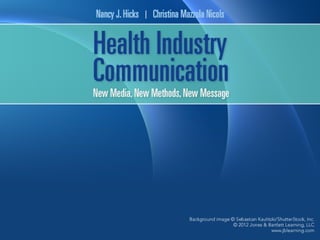
Ch03
- 2. Chapter 3 Research for Health Communication
- 3. Learning Objectives • Distinguish between qualitative and quantitative methodologies used in communication research. • Understand when to use various research methodologies and approaches to develop and support a health communication effort. • Define and distinguish between different types of epidemiologic research studies. • Define and distinguish between essential epidemiologic terms, such as incidence and prevalence.
- 4. Health Communications Programs • Planning a health communication program is a research-intensive process. – Quantitative methodologies used in communication research – Codes of ethics – Essential epidemiologic terms: prevalence, incidence, mortality rate, proportionate, mortality, outbreak, epidemic, pandemic – Epidemiologic studies, including experimental, cohort, case–control
- 5. Quantitative Research for Communication • Quantitative research categorizes variables, counts them, and then uses statistical procedures to explain them • Quantitative research is typically conducted among a representative sample of the population the communicator • Determining a sufficient sample size depends on the size of the target population is trying to reach
- 6. Quantitative Research for Communication • Larger sample sizes generally result in smaller margins of error – As a rule of thumb it should be under plus or minus 5% • Survey methodology can affect cost
- 7. Quantitative Research for Communication • When analyzing the results of surveys, communicators should be aware of the statistical procedures and terms frequently used in research for health communication – Frequency – Correlation Analysis – Cross-Tabulation – Regression Analysis – Cluster Analysis
- 9. Qualitative Research for Communication • Qualitative research aims to gather an in-depth understanding of human behavior and the factors contributing to the behavior • The sampling strategy for qualitative research differs from that of quantitative research – Probability – Purposive • Sample sizes are smaller than in quantitative research because the goal is to elicit in-depth insights rather than to generalize to the broad population
- 10. Observation and Participant- Observation • The purpose of observation is to understand behaviors in a natural setting • Marketing professionals have long used this methodology to get a firsthand understanding of the factors influencing purchase decisions • Greater insight can be gathered through participant- observation • Code of ethics – American Anthropological Association and American Sociological Association
- 11. In-Depth Interviews • Typically conducted one on one in person or by telephone – Informal, unstructured interviews – Semistructured interviews – See Table 3-2
- 12. Focus Group Sessions • Semistructured interviews conducted among small groups of participants instead of individuals • In-person focus groups are usually held in market research facilities that feature two-way mirrors to enable observers to watch participant reactions without intruding on the session • Focus groups can be conducted entirely online
- 13. Combining Qualitative and Quantitative Research • A combined approach incorporating qualitative and quantitative methodologies can be an effective means of formative research to guide the development of a communications campaign
- 14. Essential Epidemiologic Terms • To understand scientific studies as well as the broader context of public health, health communicators need to have a working knowledge of frequently used epidemiologic terms • Morbidity, mortality, proportionate mortality, outbreak, epidemic, pandemic, cluster, exposure, attack rate, etc
- 15. Introduction to Epidemiologic Studies • Health communication professionals are likely to encounter discussion of various types of epidemiologic studies